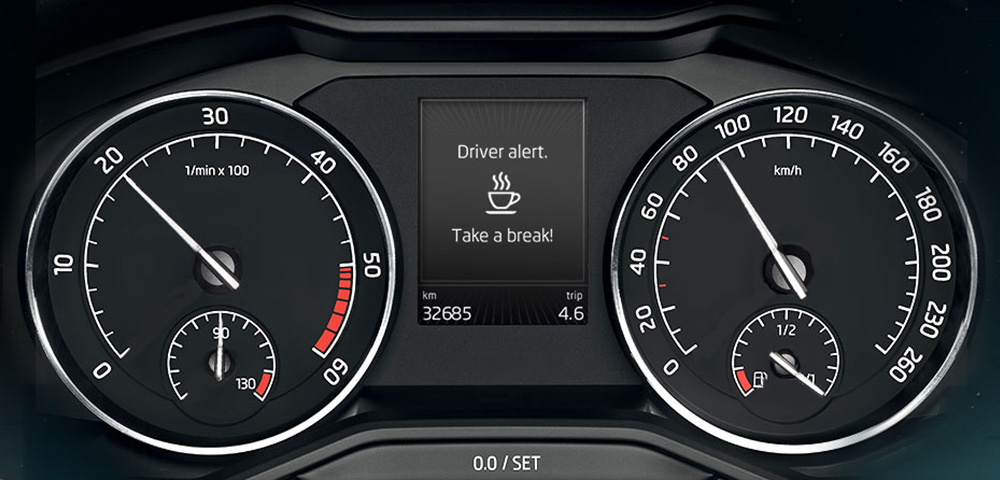“The basic advice for avoiding microsleep is to plan the journey properly. Drive at your usual speed, leave at the right time, take breaks. Some people don’t like driving in the morning, others don’t like driving at night – we should plan our trip accordingly,” Mulač explains.
There are various recommendations on what to do if you experience microsleep. Some people suggest doing some exercise, or having a coffee or an energy drink. These solutions usually work for a while, but the problem is that the fatigue can then come back even stronger. A mix of impulses can also help to a certain degree. More frequent breaks during a journey can be beneficial, or chatting to a passenger.
 Driver Alert detects signs of fatigue in the driver and prompts the driver to take a break.
Driver Alert detects signs of fatigue in the driver and prompts the driver to take a break.
Docent Šucha also says that drivers should learn to recognise the signs of tiredness. “There is no universal advice on how to recognise tiredness. You need to be aware of yourself. Put simply, it’s good when drivers actually think about tiredness,” Šucha says, adding that people have a natural tendency to ignore fatigue. “We are subconsciously trained to perform intensively and to ignore fatigue for a certain time,” he says.
The driver himself is the best assistant
There is also no reliable scientific method for detecting tiredness. “There are no reliable non-invasive methods for detecting tiredness. Things like EEG do not really work and would be inconvenient for drivers,” says Šucha. These days, cars have various fatigue detection functions but, according to Šucha, these usually only warn drivers when the level of tiredness has passed a certain threshold. Before that point, steering wheel movement sensors or cameras in the car cannot reliably recognise fatigue.

When microsleep actually occurs, even traditional assistance systems that help drivers in standard situations will not necessarily save him. “Let’s take a hypothetical situation, where a lane keeping assistance system keeps a car on a nice straight road between fields with a driver experiencing microsleep,” Karel Mulač says, setting the scene. “The driver wakes up – nothing has happened and he continues on his way. A few kilometres later he’s on a windy road in a forest and falls asleep again. Instead of the car leaving the road and going into a field with minimal consequences, the car could collide with a tree,” he explains.
Even so, in some situations a ŠKODA can save a driver experiencing microsleep. Cars equipped with the Emergency Assist system can stop themselves if necessary and switch on the hazard lights. The system is activated automatically if the driver is incapacitated: first it emits a warning signal for the driver, then the car initiates a short swerve. If the driver still does not respond, a car with a DSG gearbox can automatically stop. One way or another, advanced modern assistance systems are nothing more than a good helper, and to work effectively they need one thing – a well-rested and alert driver.


 ŠKODA SUPERB and Smart Light Assist - a very good helper at night, but only for the vigilant driver
ŠKODA SUPERB and Smart Light Assist - a very good helper at night, but only for the vigilant driver
 Driver Alert detects signs of fatigue in the driver and prompts the driver to take a break.
Driver Alert detects signs of fatigue in the driver and prompts the driver to take a break.



















